Taxation Law Assignment T1 2018, Taxation 2, University XYZ
VerifiedAdded on 2020/04/15
|13
|3441
|283
Homework Assignment
AI Summary
This taxation law assignment solution addresses several key concepts within Australian taxation law. It begins by defining permanent establishment and its implications under tax treaties, referencing the ITAA 1997 and relevant OECD models. The assignment then explores the concept of taxable income, using the case of an MLB prospect as an example, and analyzes the tax implications of different income sources, including salary and rental income. The solution also delves into the Myer doctrine, examining how profits from one-off transactions are treated as ordinary income, with references to several court cases. Finally, it examines deductible expenses, differentiating between capital and revenue expenditure and discussing the conditions under which expenses can be deducted, including interest on loans. The assignment draws on various court cases and legislative provisions to support its arguments.

Running head: TAXATION LAW
Taxation Law
Name of the Student
Name of the University
Authors Note
Course ID
Taxation Law
Name of the Student
Name of the University
Authors Note
Course ID
Paraphrase This Document
Need a fresh take? Get an instant paraphrase of this document with our AI Paraphraser

1TAXATION LAW
Table of Contents
Taxation 2 Assignment T1 2018:...............................................................................................2
Answer to Question 1:................................................................................................................2
Answer to A:..............................................................................................................................2
Answer to B:..............................................................................................................................2
Answer to C:..............................................................................................................................3
Answer to question 2:.................................................................................................................3
Answer to question 3:.................................................................................................................5
Answer to question 4:.................................................................................................................6
Answer to A:..............................................................................................................................6
Answer to B:..............................................................................................................................7
Answer to C:..............................................................................................................................8
Answer to question 5:.................................................................................................................8
Reference List:.........................................................................................................................10
Table of Contents
Taxation 2 Assignment T1 2018:...............................................................................................2
Answer to Question 1:................................................................................................................2
Answer to A:..............................................................................................................................2
Answer to B:..............................................................................................................................2
Answer to C:..............................................................................................................................3
Answer to question 2:.................................................................................................................3
Answer to question 3:.................................................................................................................5
Answer to question 4:.................................................................................................................6
Answer to A:..............................................................................................................................6
Answer to B:..............................................................................................................................7
Answer to C:..............................................................................................................................8
Answer to question 5:.................................................................................................................8
Reference List:.........................................................................................................................10
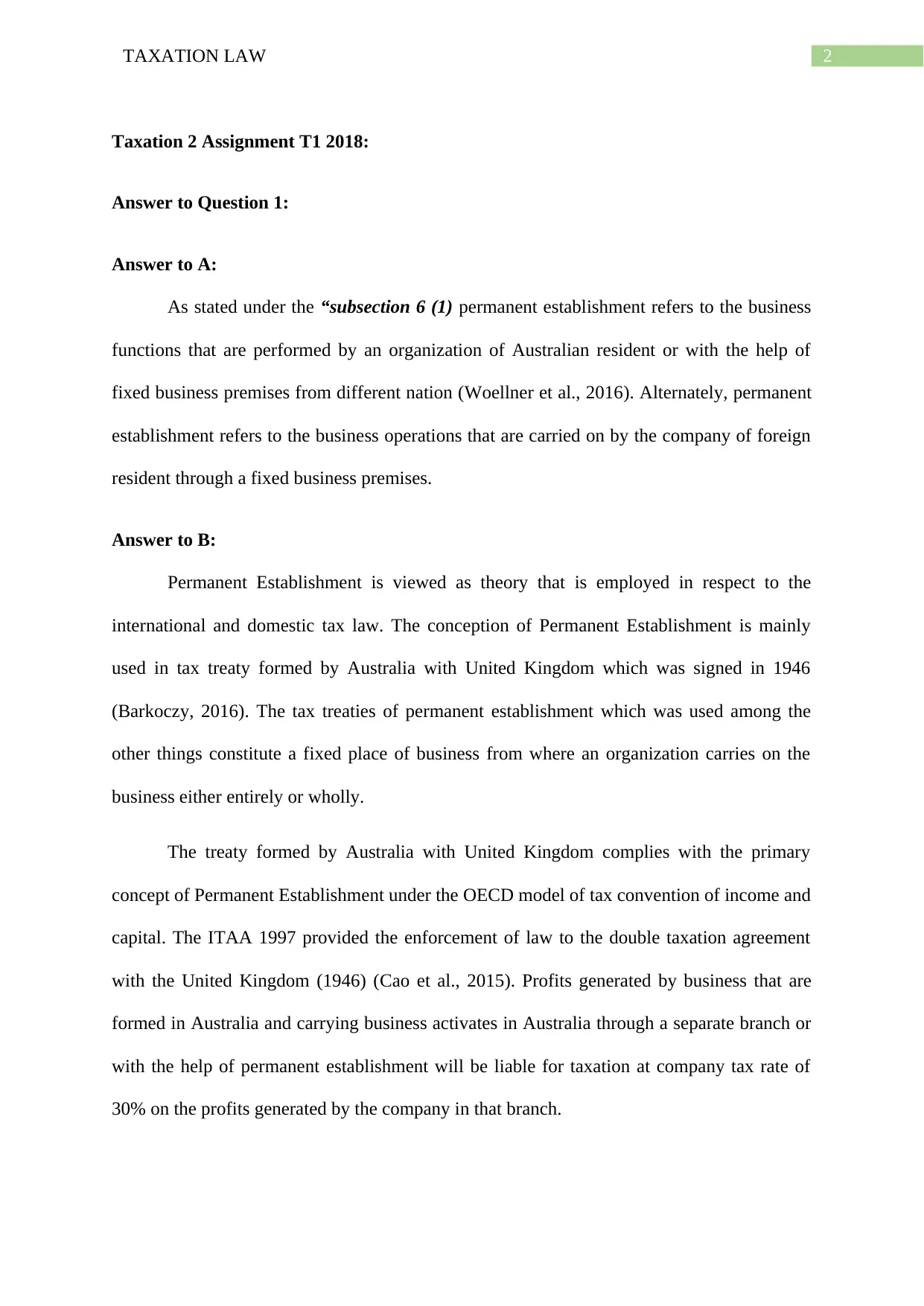
2TAXATION LAW
Taxation 2 Assignment T1 2018:
Answer to Question 1:
Answer to A:
As stated under the “subsection 6 (1) permanent establishment refers to the business
functions that are performed by an organization of Australian resident or with the help of
fixed business premises from different nation (Woellner et al., 2016). Alternately, permanent
establishment refers to the business operations that are carried on by the company of foreign
resident through a fixed business premises.
Answer to B:
Permanent Establishment is viewed as theory that is employed in respect to the
international and domestic tax law. The conception of Permanent Establishment is mainly
used in tax treaty formed by Australia with United Kingdom which was signed in 1946
(Barkoczy, 2016). The tax treaties of permanent establishment which was used among the
other things constitute a fixed place of business from where an organization carries on the
business either entirely or wholly.
The treaty formed by Australia with United Kingdom complies with the primary
concept of Permanent Establishment under the OECD model of tax convention of income and
capital. The ITAA 1997 provided the enforcement of law to the double taxation agreement
with the United Kingdom (1946) (Cao et al., 2015). Profits generated by business that are
formed in Australia and carrying business activates in Australia through a separate branch or
with the help of permanent establishment will be liable for taxation at company tax rate of
30% on the profits generated by the company in that branch.
Taxation 2 Assignment T1 2018:
Answer to Question 1:
Answer to A:
As stated under the “subsection 6 (1) permanent establishment refers to the business
functions that are performed by an organization of Australian resident or with the help of
fixed business premises from different nation (Woellner et al., 2016). Alternately, permanent
establishment refers to the business operations that are carried on by the company of foreign
resident through a fixed business premises.
Answer to B:
Permanent Establishment is viewed as theory that is employed in respect to the
international and domestic tax law. The conception of Permanent Establishment is mainly
used in tax treaty formed by Australia with United Kingdom which was signed in 1946
(Barkoczy, 2016). The tax treaties of permanent establishment which was used among the
other things constitute a fixed place of business from where an organization carries on the
business either entirely or wholly.
The treaty formed by Australia with United Kingdom complies with the primary
concept of Permanent Establishment under the OECD model of tax convention of income and
capital. The ITAA 1997 provided the enforcement of law to the double taxation agreement
with the United Kingdom (1946) (Cao et al., 2015). Profits generated by business that are
formed in Australia and carrying business activates in Australia through a separate branch or
with the help of permanent establishment will be liable for taxation at company tax rate of
30% on the profits generated by the company in that branch.
You're viewing a preview
Unlock full access by subscribing today!
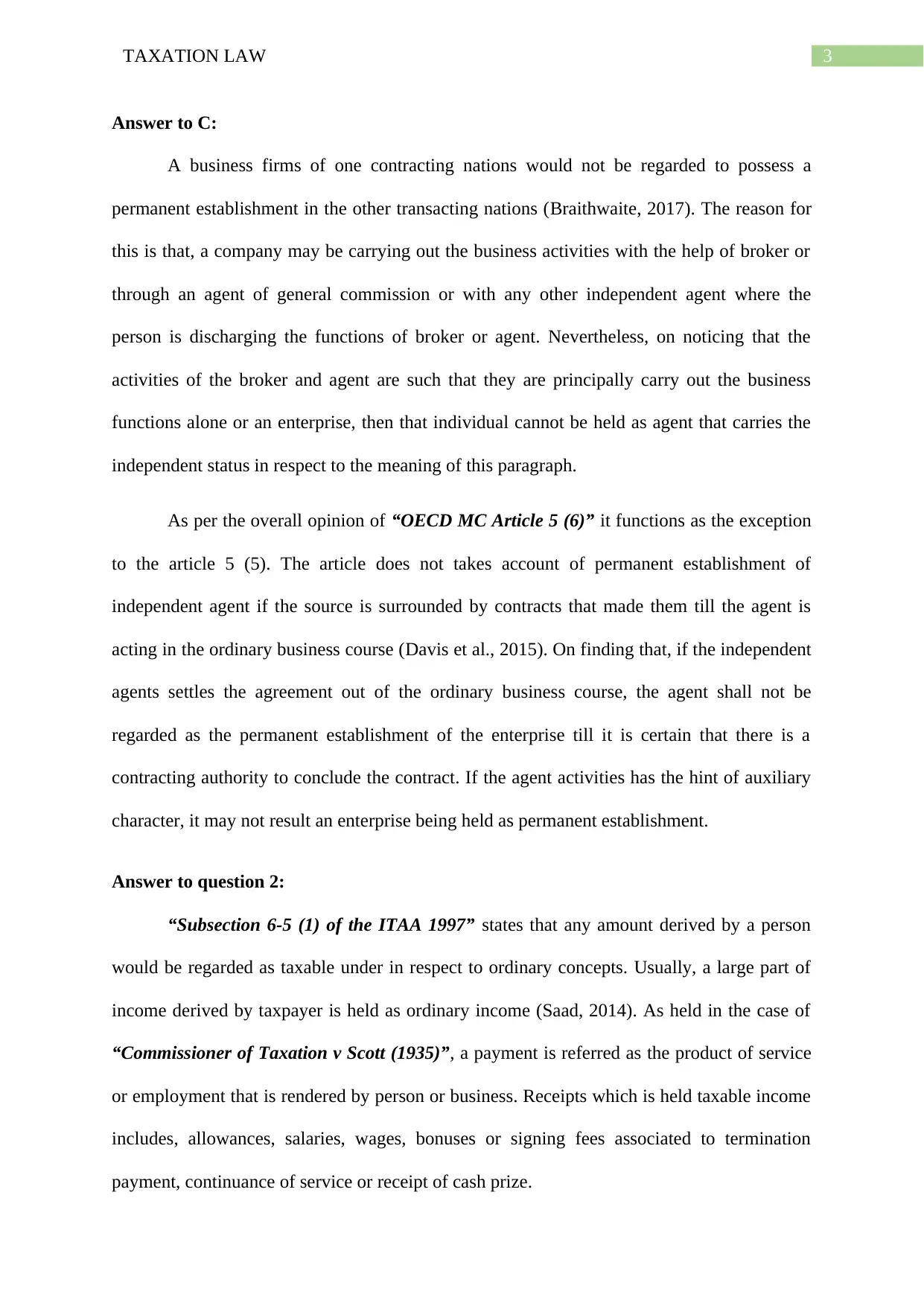
3TAXATION LAW
Answer to C:
A business firms of one contracting nations would not be regarded to possess a
permanent establishment in the other transacting nations (Braithwaite, 2017). The reason for
this is that, a company may be carrying out the business activities with the help of broker or
through an agent of general commission or with any other independent agent where the
person is discharging the functions of broker or agent. Nevertheless, on noticing that the
activities of the broker and agent are such that they are principally carry out the business
functions alone or an enterprise, then that individual cannot be held as agent that carries the
independent status in respect to the meaning of this paragraph.
As per the overall opinion of “OECD MC Article 5 (6)” it functions as the exception
to the article 5 (5). The article does not takes account of permanent establishment of
independent agent if the source is surrounded by contracts that made them till the agent is
acting in the ordinary business course (Davis et al., 2015). On finding that, if the independent
agents settles the agreement out of the ordinary business course, the agent shall not be
regarded as the permanent establishment of the enterprise till it is certain that there is a
contracting authority to conclude the contract. If the agent activities has the hint of auxiliary
character, it may not result an enterprise being held as permanent establishment.
Answer to question 2:
“Subsection 6-5 (1) of the ITAA 1997” states that any amount derived by a person
would be regarded as taxable under in respect to ordinary concepts. Usually, a large part of
income derived by taxpayer is held as ordinary income (Saad, 2014). As held in the case of
“Commissioner of Taxation v Scott (1935)”, a payment is referred as the product of service
or employment that is rendered by person or business. Receipts which is held taxable income
includes, allowances, salaries, wages, bonuses or signing fees associated to termination
payment, continuance of service or receipt of cash prize.
Answer to C:
A business firms of one contracting nations would not be regarded to possess a
permanent establishment in the other transacting nations (Braithwaite, 2017). The reason for
this is that, a company may be carrying out the business activities with the help of broker or
through an agent of general commission or with any other independent agent where the
person is discharging the functions of broker or agent. Nevertheless, on noticing that the
activities of the broker and agent are such that they are principally carry out the business
functions alone or an enterprise, then that individual cannot be held as agent that carries the
independent status in respect to the meaning of this paragraph.
As per the overall opinion of “OECD MC Article 5 (6)” it functions as the exception
to the article 5 (5). The article does not takes account of permanent establishment of
independent agent if the source is surrounded by contracts that made them till the agent is
acting in the ordinary business course (Davis et al., 2015). On finding that, if the independent
agents settles the agreement out of the ordinary business course, the agent shall not be
regarded as the permanent establishment of the enterprise till it is certain that there is a
contracting authority to conclude the contract. If the agent activities has the hint of auxiliary
character, it may not result an enterprise being held as permanent establishment.
Answer to question 2:
“Subsection 6-5 (1) of the ITAA 1997” states that any amount derived by a person
would be regarded as taxable under in respect to ordinary concepts. Usually, a large part of
income derived by taxpayer is held as ordinary income (Saad, 2014). As held in the case of
“Commissioner of Taxation v Scott (1935)”, a payment is referred as the product of service
or employment that is rendered by person or business. Receipts which is held taxable income
includes, allowances, salaries, wages, bonuses or signing fees associated to termination
payment, continuance of service or receipt of cash prize.
Paraphrase This Document
Need a fresh take? Get an instant paraphrase of this document with our AI Paraphraser
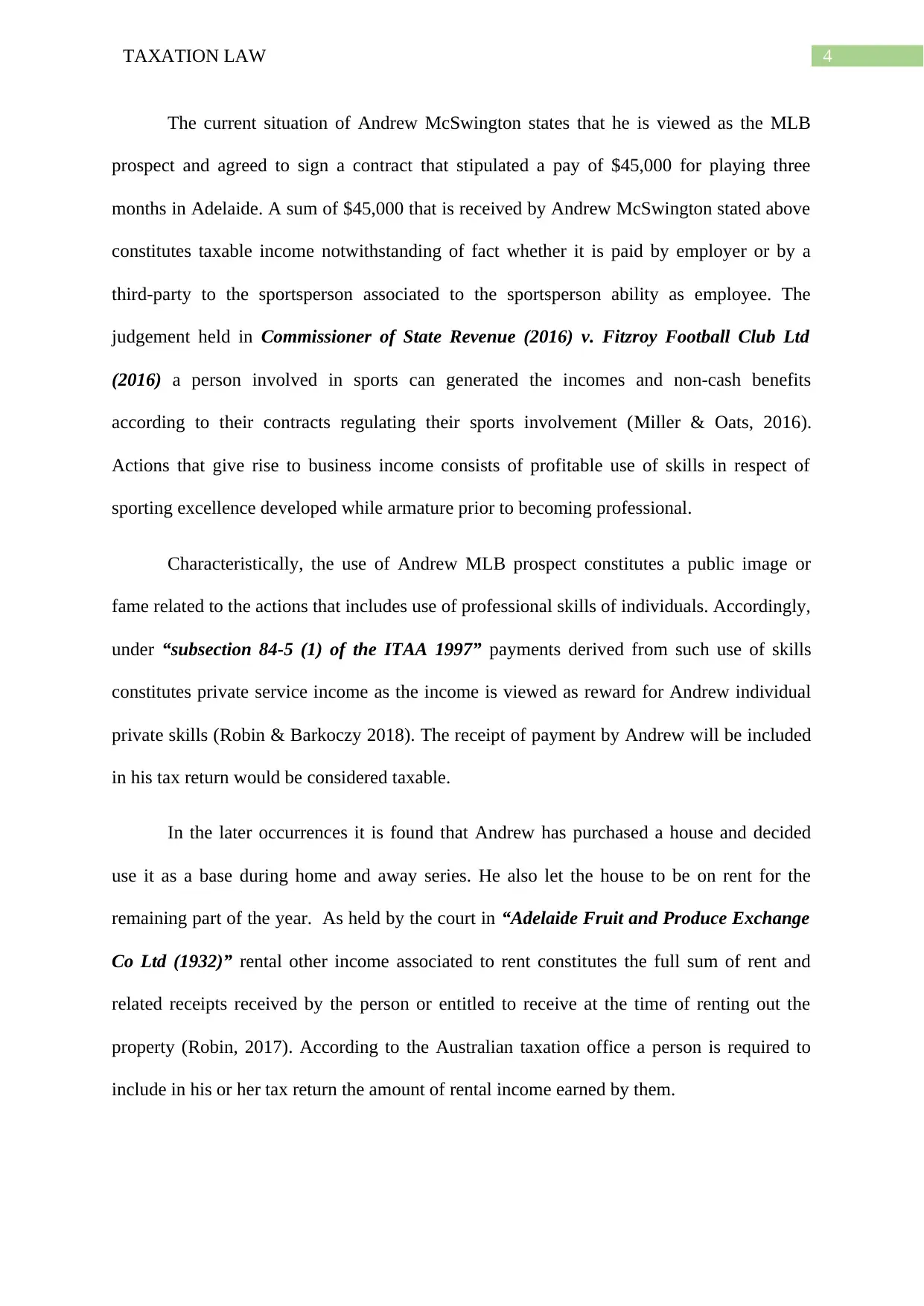
4TAXATION LAW
The current situation of Andrew McSwington states that he is viewed as the MLB
prospect and agreed to sign a contract that stipulated a pay of $45,000 for playing three
months in Adelaide. A sum of $45,000 that is received by Andrew McSwington stated above
constitutes taxable income notwithstanding of fact whether it is paid by employer or by a
third-party to the sportsperson associated to the sportsperson ability as employee. The
judgement held in Commissioner of State Revenue (2016) v. Fitzroy Football Club Ltd
(2016) a person involved in sports can generated the incomes and non-cash benefits
according to their contracts regulating their sports involvement (Miller & Oats, 2016).
Actions that give rise to business income consists of profitable use of skills in respect of
sporting excellence developed while armature prior to becoming professional.
Characteristically, the use of Andrew MLB prospect constitutes a public image or
fame related to the actions that includes use of professional skills of individuals. Accordingly,
under “subsection 84-5 (1) of the ITAA 1997” payments derived from such use of skills
constitutes private service income as the income is viewed as reward for Andrew individual
private skills (Robin & Barkoczy 2018). The receipt of payment by Andrew will be included
in his tax return would be considered taxable.
In the later occurrences it is found that Andrew has purchased a house and decided
use it as a base during home and away series. He also let the house to be on rent for the
remaining part of the year. As held by the court in “Adelaide Fruit and Produce Exchange
Co Ltd (1932)” rental other income associated to rent constitutes the full sum of rent and
related receipts received by the person or entitled to receive at the time of renting out the
property (Robin, 2017). According to the Australian taxation office a person is required to
include in his or her tax return the amount of rental income earned by them.
The current situation of Andrew McSwington states that he is viewed as the MLB
prospect and agreed to sign a contract that stipulated a pay of $45,000 for playing three
months in Adelaide. A sum of $45,000 that is received by Andrew McSwington stated above
constitutes taxable income notwithstanding of fact whether it is paid by employer or by a
third-party to the sportsperson associated to the sportsperson ability as employee. The
judgement held in Commissioner of State Revenue (2016) v. Fitzroy Football Club Ltd
(2016) a person involved in sports can generated the incomes and non-cash benefits
according to their contracts regulating their sports involvement (Miller & Oats, 2016).
Actions that give rise to business income consists of profitable use of skills in respect of
sporting excellence developed while armature prior to becoming professional.
Characteristically, the use of Andrew MLB prospect constitutes a public image or
fame related to the actions that includes use of professional skills of individuals. Accordingly,
under “subsection 84-5 (1) of the ITAA 1997” payments derived from such use of skills
constitutes private service income as the income is viewed as reward for Andrew individual
private skills (Robin & Barkoczy 2018). The receipt of payment by Andrew will be included
in his tax return would be considered taxable.
In the later occurrences it is found that Andrew has purchased a house and decided
use it as a base during home and away series. He also let the house to be on rent for the
remaining part of the year. As held by the court in “Adelaide Fruit and Produce Exchange
Co Ltd (1932)” rental other income associated to rent constitutes the full sum of rent and
related receipts received by the person or entitled to receive at the time of renting out the
property (Robin, 2017). According to the Australian taxation office a person is required to
include in his or her tax return the amount of rental income earned by them.
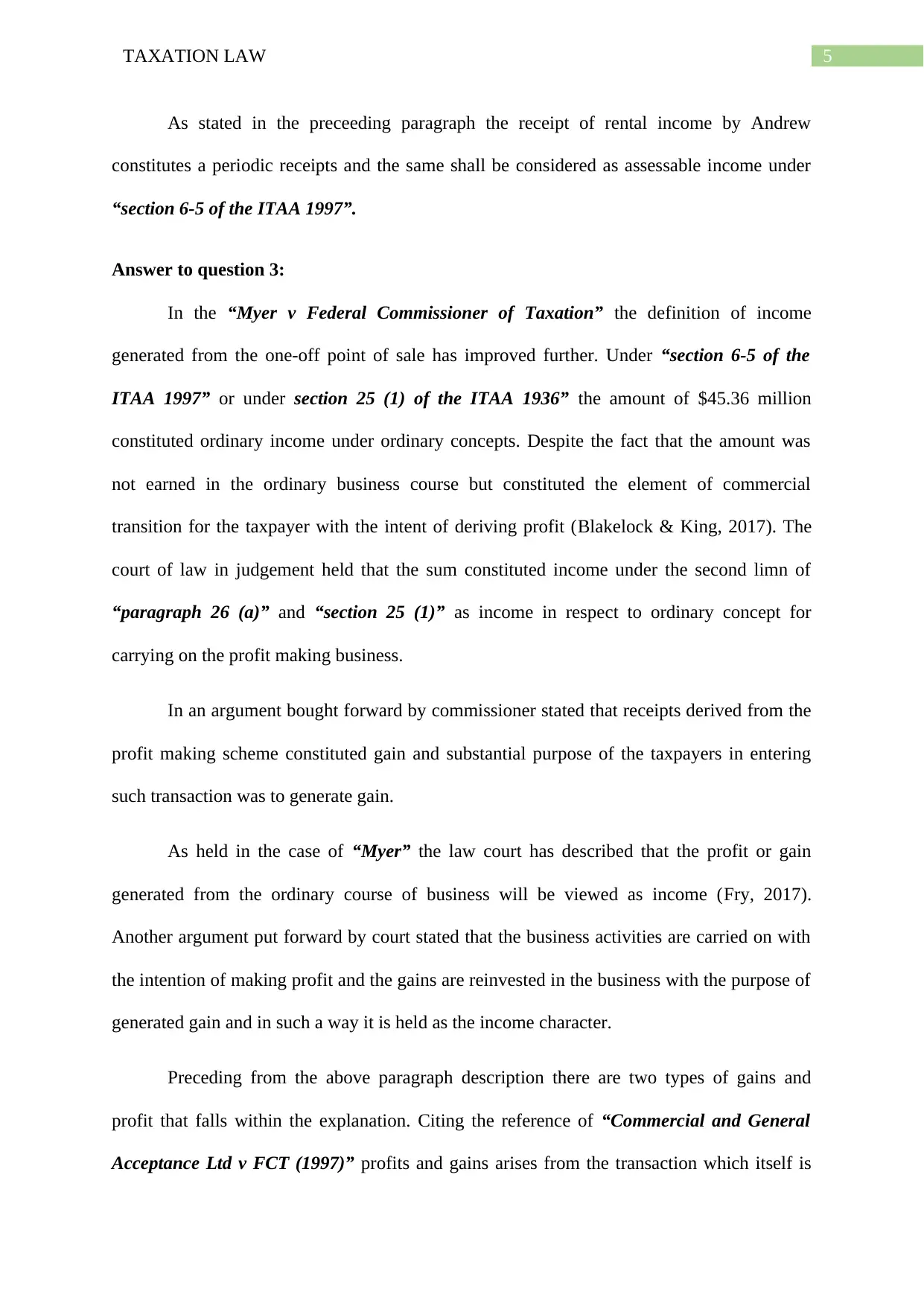
5TAXATION LAW
As stated in the preceeding paragraph the receipt of rental income by Andrew
constitutes a periodic receipts and the same shall be considered as assessable income under
“section 6-5 of the ITAA 1997”.
Answer to question 3:
In the “Myer v Federal Commissioner of Taxation” the definition of income
generated from the one-off point of sale has improved further. Under “section 6-5 of the
ITAA 1997” or under section 25 (1) of the ITAA 1936” the amount of $45.36 million
constituted ordinary income under ordinary concepts. Despite the fact that the amount was
not earned in the ordinary business course but constituted the element of commercial
transition for the taxpayer with the intent of deriving profit (Blakelock & King, 2017). The
court of law in judgement held that the sum constituted income under the second limn of
“paragraph 26 (a)” and “section 25 (1)” as income in respect to ordinary concept for
carrying on the profit making business.
In an argument bought forward by commissioner stated that receipts derived from the
profit making scheme constituted gain and substantial purpose of the taxpayers in entering
such transaction was to generate gain.
As held in the case of “Myer” the law court has described that the profit or gain
generated from the ordinary course of business will be viewed as income (Fry, 2017).
Another argument put forward by court stated that the business activities are carried on with
the intention of making profit and the gains are reinvested in the business with the purpose of
generated gain and in such a way it is held as the income character.
Preceding from the above paragraph description there are two types of gains and
profit that falls within the explanation. Citing the reference of “Commercial and General
Acceptance Ltd v FCT (1997)” profits and gains arises from the transaction which itself is
As stated in the preceeding paragraph the receipt of rental income by Andrew
constitutes a periodic receipts and the same shall be considered as assessable income under
“section 6-5 of the ITAA 1997”.
Answer to question 3:
In the “Myer v Federal Commissioner of Taxation” the definition of income
generated from the one-off point of sale has improved further. Under “section 6-5 of the
ITAA 1997” or under section 25 (1) of the ITAA 1936” the amount of $45.36 million
constituted ordinary income under ordinary concepts. Despite the fact that the amount was
not earned in the ordinary business course but constituted the element of commercial
transition for the taxpayer with the intent of deriving profit (Blakelock & King, 2017). The
court of law in judgement held that the sum constituted income under the second limn of
“paragraph 26 (a)” and “section 25 (1)” as income in respect to ordinary concept for
carrying on the profit making business.
In an argument bought forward by commissioner stated that receipts derived from the
profit making scheme constituted gain and substantial purpose of the taxpayers in entering
such transaction was to generate gain.
As held in the case of “Myer” the law court has described that the profit or gain
generated from the ordinary course of business will be viewed as income (Fry, 2017).
Another argument put forward by court stated that the business activities are carried on with
the intention of making profit and the gains are reinvested in the business with the purpose of
generated gain and in such a way it is held as the income character.
Preceding from the above paragraph description there are two types of gains and
profit that falls within the explanation. Citing the reference of “Commercial and General
Acceptance Ltd v FCT (1997)” profits and gains arises from the transaction which itself is
You're viewing a preview
Unlock full access by subscribing today!

6TAXATION LAW
the element of taxpayers ordinary business (Mitu & Stanciu, 2018). The court of law also
referred to Chamber of Manufacturer Insurance Ltd (1984) v FCT (1984” profits and gains
arising out of the ordinary business transaction even though not entered into by taxpayer
directly would be held as ordinary income.
Preceding from above discussion a reference of “Whitfords Beach v. Federal
Commissioner of Taxation (1982)” can be cited where the court held that net gain or profit
derived from business activities would be held as ordinary income (Martins & Sa, 2018). The
concept of income has expanded to account for the assured net gains generated from the
business. Referring to the case of “Cooling v FCT (1990)” the principles of Myer doctrine
was implemented by the court of law to give its verdict. According to the opinion of court the
taxpayer entered into the commercial transaction (Moisescu, 2018). The transaction entered
into by the taxpayer constituted significant portion of business activity with no use of
insignificant purpose was made to derive the commercial profit through incentive payment.
As held in “Rotherwood v. Federal commissioner of taxation (1994)” the court of
law found that the receipt of cash incentive paid to the taxpayer for signing the longer lease
constituted income under ordinary concept (Coleman & Sadiq, 2013). So far all over again,
the court of law used the “Myer” case to arrive at the conclusions that arrangement
constituted a profit making scheme. Therefore, the Myer case illustrates the singular business
transaction and the law court referring to “Federal Commissioner of Taxation v Cooling
(1990)” correctly pronounced that the receipt would be held as ordinary income of firms
business activities.
the element of taxpayers ordinary business (Mitu & Stanciu, 2018). The court of law also
referred to Chamber of Manufacturer Insurance Ltd (1984) v FCT (1984” profits and gains
arising out of the ordinary business transaction even though not entered into by taxpayer
directly would be held as ordinary income.
Preceding from above discussion a reference of “Whitfords Beach v. Federal
Commissioner of Taxation (1982)” can be cited where the court held that net gain or profit
derived from business activities would be held as ordinary income (Martins & Sa, 2018). The
concept of income has expanded to account for the assured net gains generated from the
business. Referring to the case of “Cooling v FCT (1990)” the principles of Myer doctrine
was implemented by the court of law to give its verdict. According to the opinion of court the
taxpayer entered into the commercial transaction (Moisescu, 2018). The transaction entered
into by the taxpayer constituted significant portion of business activity with no use of
insignificant purpose was made to derive the commercial profit through incentive payment.
As held in “Rotherwood v. Federal commissioner of taxation (1994)” the court of
law found that the receipt of cash incentive paid to the taxpayer for signing the longer lease
constituted income under ordinary concept (Coleman & Sadiq, 2013). So far all over again,
the court of law used the “Myer” case to arrive at the conclusions that arrangement
constituted a profit making scheme. Therefore, the Myer case illustrates the singular business
transaction and the law court referring to “Federal Commissioner of Taxation v Cooling
(1990)” correctly pronounced that the receipt would be held as ordinary income of firms
business activities.
Paraphrase This Document
Need a fresh take? Get an instant paraphrase of this document with our AI Paraphraser
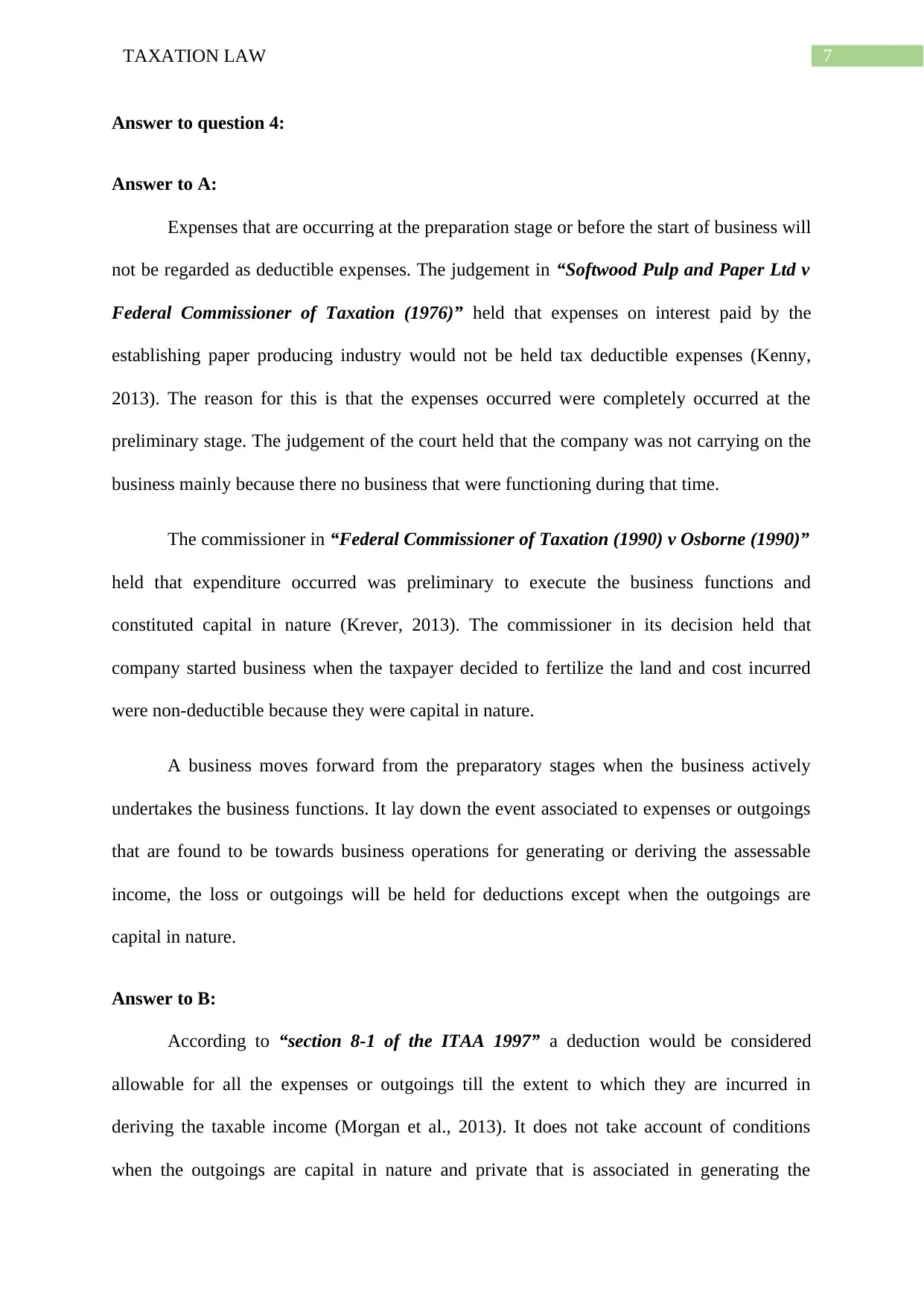
7TAXATION LAW
Answer to question 4:
Answer to A:
Expenses that are occurring at the preparation stage or before the start of business will
not be regarded as deductible expenses. The judgement in “Softwood Pulp and Paper Ltd v
Federal Commissioner of Taxation (1976)” held that expenses on interest paid by the
establishing paper producing industry would not be held tax deductible expenses (Kenny,
2013). The reason for this is that the expenses occurred were completely occurred at the
preliminary stage. The judgement of the court held that the company was not carrying on the
business mainly because there no business that were functioning during that time.
The commissioner in “Federal Commissioner of Taxation (1990) v Osborne (1990)”
held that expenditure occurred was preliminary to execute the business functions and
constituted capital in nature (Krever, 2013). The commissioner in its decision held that
company started business when the taxpayer decided to fertilize the land and cost incurred
were non-deductible because they were capital in nature.
A business moves forward from the preparatory stages when the business actively
undertakes the business functions. It lay down the event associated to expenses or outgoings
that are found to be towards business operations for generating or deriving the assessable
income, the loss or outgoings will be held for deductions except when the outgoings are
capital in nature.
Answer to B:
According to “section 8-1 of the ITAA 1997” a deduction would be considered
allowable for all the expenses or outgoings till the extent to which they are incurred in
deriving the taxable income (Morgan et al., 2013). It does not take account of conditions
when the outgoings are capital in nature and private that is associated in generating the
Answer to question 4:
Answer to A:
Expenses that are occurring at the preparation stage or before the start of business will
not be regarded as deductible expenses. The judgement in “Softwood Pulp and Paper Ltd v
Federal Commissioner of Taxation (1976)” held that expenses on interest paid by the
establishing paper producing industry would not be held tax deductible expenses (Kenny,
2013). The reason for this is that the expenses occurred were completely occurred at the
preliminary stage. The judgement of the court held that the company was not carrying on the
business mainly because there no business that were functioning during that time.
The commissioner in “Federal Commissioner of Taxation (1990) v Osborne (1990)”
held that expenditure occurred was preliminary to execute the business functions and
constituted capital in nature (Krever, 2013). The commissioner in its decision held that
company started business when the taxpayer decided to fertilize the land and cost incurred
were non-deductible because they were capital in nature.
A business moves forward from the preparatory stages when the business actively
undertakes the business functions. It lay down the event associated to expenses or outgoings
that are found to be towards business operations for generating or deriving the assessable
income, the loss or outgoings will be held for deductions except when the outgoings are
capital in nature.
Answer to B:
According to “section 8-1 of the ITAA 1997” a deduction would be considered
allowable for all the expenses or outgoings till the extent to which they are incurred in
deriving the taxable income (Morgan et al., 2013). It does not take account of conditions
when the outgoings are capital in nature and private that is associated in generating the
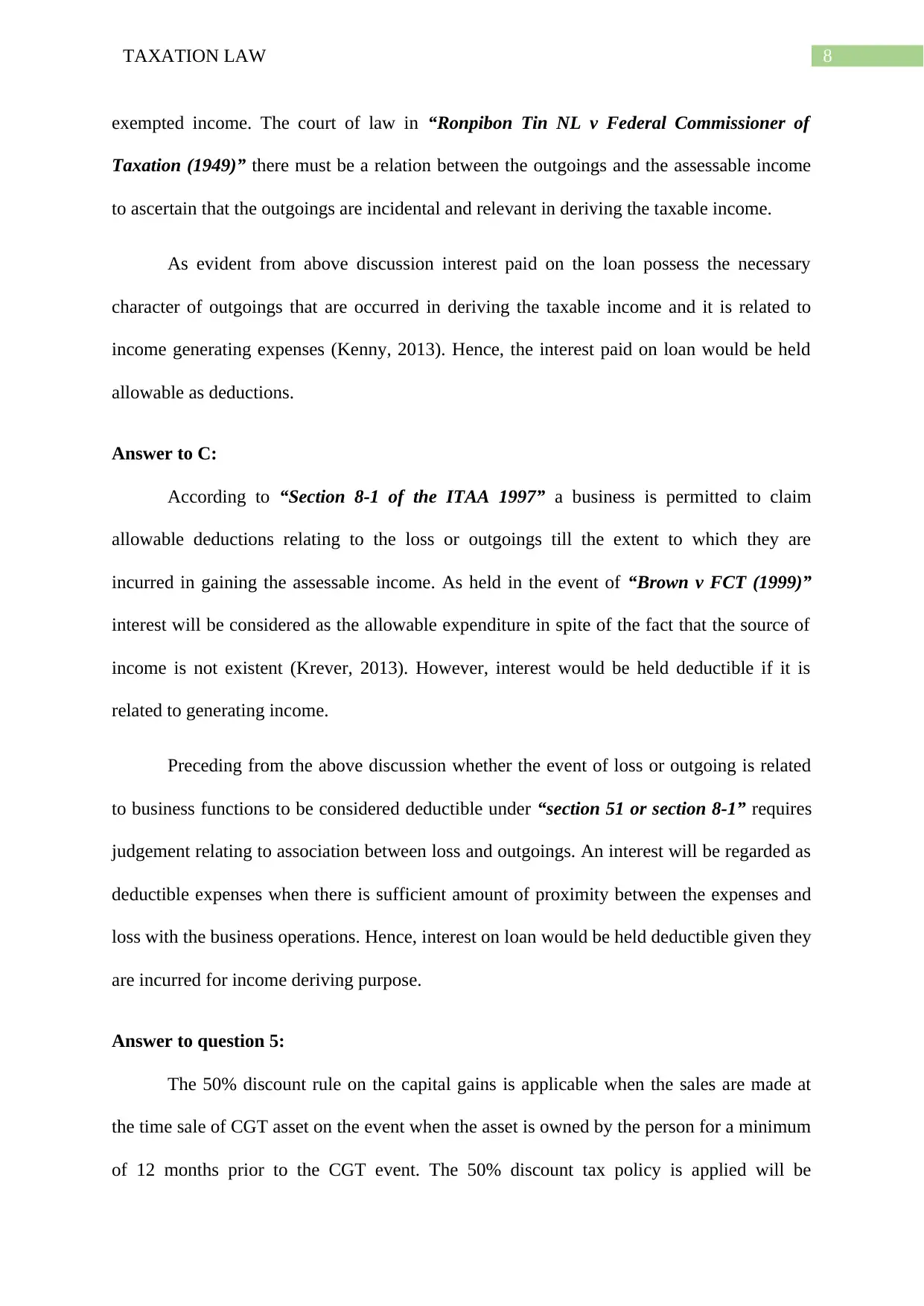
8TAXATION LAW
exempted income. The court of law in “Ronpibon Tin NL v Federal Commissioner of
Taxation (1949)” there must be a relation between the outgoings and the assessable income
to ascertain that the outgoings are incidental and relevant in deriving the taxable income.
As evident from above discussion interest paid on the loan possess the necessary
character of outgoings that are occurred in deriving the taxable income and it is related to
income generating expenses (Kenny, 2013). Hence, the interest paid on loan would be held
allowable as deductions.
Answer to C:
According to “Section 8-1 of the ITAA 1997” a business is permitted to claim
allowable deductions relating to the loss or outgoings till the extent to which they are
incurred in gaining the assessable income. As held in the event of “Brown v FCT (1999)”
interest will be considered as the allowable expenditure in spite of the fact that the source of
income is not existent (Krever, 2013). However, interest would be held deductible if it is
related to generating income.
Preceding from the above discussion whether the event of loss or outgoing is related
to business functions to be considered deductible under “section 51 or section 8-1” requires
judgement relating to association between loss and outgoings. An interest will be regarded as
deductible expenses when there is sufficient amount of proximity between the expenses and
loss with the business operations. Hence, interest on loan would be held deductible given they
are incurred for income deriving purpose.
Answer to question 5:
The 50% discount rule on the capital gains is applicable when the sales are made at
the time sale of CGT asset on the event when the asset is owned by the person for a minimum
of 12 months prior to the CGT event. The 50% discount tax policy is applied will be
exempted income. The court of law in “Ronpibon Tin NL v Federal Commissioner of
Taxation (1949)” there must be a relation between the outgoings and the assessable income
to ascertain that the outgoings are incidental and relevant in deriving the taxable income.
As evident from above discussion interest paid on the loan possess the necessary
character of outgoings that are occurred in deriving the taxable income and it is related to
income generating expenses (Kenny, 2013). Hence, the interest paid on loan would be held
allowable as deductions.
Answer to C:
According to “Section 8-1 of the ITAA 1997” a business is permitted to claim
allowable deductions relating to the loss or outgoings till the extent to which they are
incurred in gaining the assessable income. As held in the event of “Brown v FCT (1999)”
interest will be considered as the allowable expenditure in spite of the fact that the source of
income is not existent (Krever, 2013). However, interest would be held deductible if it is
related to generating income.
Preceding from the above discussion whether the event of loss or outgoing is related
to business functions to be considered deductible under “section 51 or section 8-1” requires
judgement relating to association between loss and outgoings. An interest will be regarded as
deductible expenses when there is sufficient amount of proximity between the expenses and
loss with the business operations. Hence, interest on loan would be held deductible given they
are incurred for income deriving purpose.
Answer to question 5:
The 50% discount rule on the capital gains is applicable when the sales are made at
the time sale of CGT asset on the event when the asset is owned by the person for a minimum
of 12 months prior to the CGT event. The 50% discount tax policy is applied will be
You're viewing a preview
Unlock full access by subscribing today!

9TAXATION LAW
considered as the tax system as it would help in lowering the burden of tax liabilities
(Coleman & Sadiq, 2013). The policy of taxation is regarded as good system of taxation since
capital gains of individuals can be lowered down with the help of 50% discount before
including the taxable income. The capital gains concession is applied on the circumstances
where the CGT asset has been held for more than 12 months and was available regardless of
the tax residential status.
Gains that are derived on the mutually owned assets must be distributed through the
share of ownership. For example, a partner under the partnership firms would be able to
generate gains on the sale of the jointly held asset and the amount of gains that are generated
under the 50% CGT discount proportion would amount to half (Blakelock & King, 2017). A
person would only be required to pay the tax based on the proportion of gains made. This
constitutes that only half portion of the total gains would be added in the individual pool of
taxable income resulting the person to pay less amount of tax.
Support has been offered on the current role of CGT discounts as this would help in
avoiding the taxing of capital gains that arises from inflated increase of house price opposing
the value of land property due to development. An assertion bought forward by Woellner et
al., (2016) CGT discount could not be regarded as the bad taxation policy nevertheless there
are certain degree of discounts that are very generous and are exposed to exploitation.
As stated by Coleman & Sadiq, (2013) it is stated that changes in one form of taxation
would create an interfere in the economy especially if it is only targeted in the direction of
one particular type of assets. An argument bought forward by Davis et al., (2015) it is advised
that the approach should be all-inclusive to rectify the fixation of disorganization and
treatment of tax should be equal among all forms of venture and investments.
considered as the tax system as it would help in lowering the burden of tax liabilities
(Coleman & Sadiq, 2013). The policy of taxation is regarded as good system of taxation since
capital gains of individuals can be lowered down with the help of 50% discount before
including the taxable income. The capital gains concession is applied on the circumstances
where the CGT asset has been held for more than 12 months and was available regardless of
the tax residential status.
Gains that are derived on the mutually owned assets must be distributed through the
share of ownership. For example, a partner under the partnership firms would be able to
generate gains on the sale of the jointly held asset and the amount of gains that are generated
under the 50% CGT discount proportion would amount to half (Blakelock & King, 2017). A
person would only be required to pay the tax based on the proportion of gains made. This
constitutes that only half portion of the total gains would be added in the individual pool of
taxable income resulting the person to pay less amount of tax.
Support has been offered on the current role of CGT discounts as this would help in
avoiding the taxing of capital gains that arises from inflated increase of house price opposing
the value of land property due to development. An assertion bought forward by Woellner et
al., (2016) CGT discount could not be regarded as the bad taxation policy nevertheless there
are certain degree of discounts that are very generous and are exposed to exploitation.
As stated by Coleman & Sadiq, (2013) it is stated that changes in one form of taxation
would create an interfere in the economy especially if it is only targeted in the direction of
one particular type of assets. An argument bought forward by Davis et al., (2015) it is advised
that the approach should be all-inclusive to rectify the fixation of disorganization and
treatment of tax should be equal among all forms of venture and investments.
Paraphrase This Document
Need a fresh take? Get an instant paraphrase of this document with our AI Paraphraser
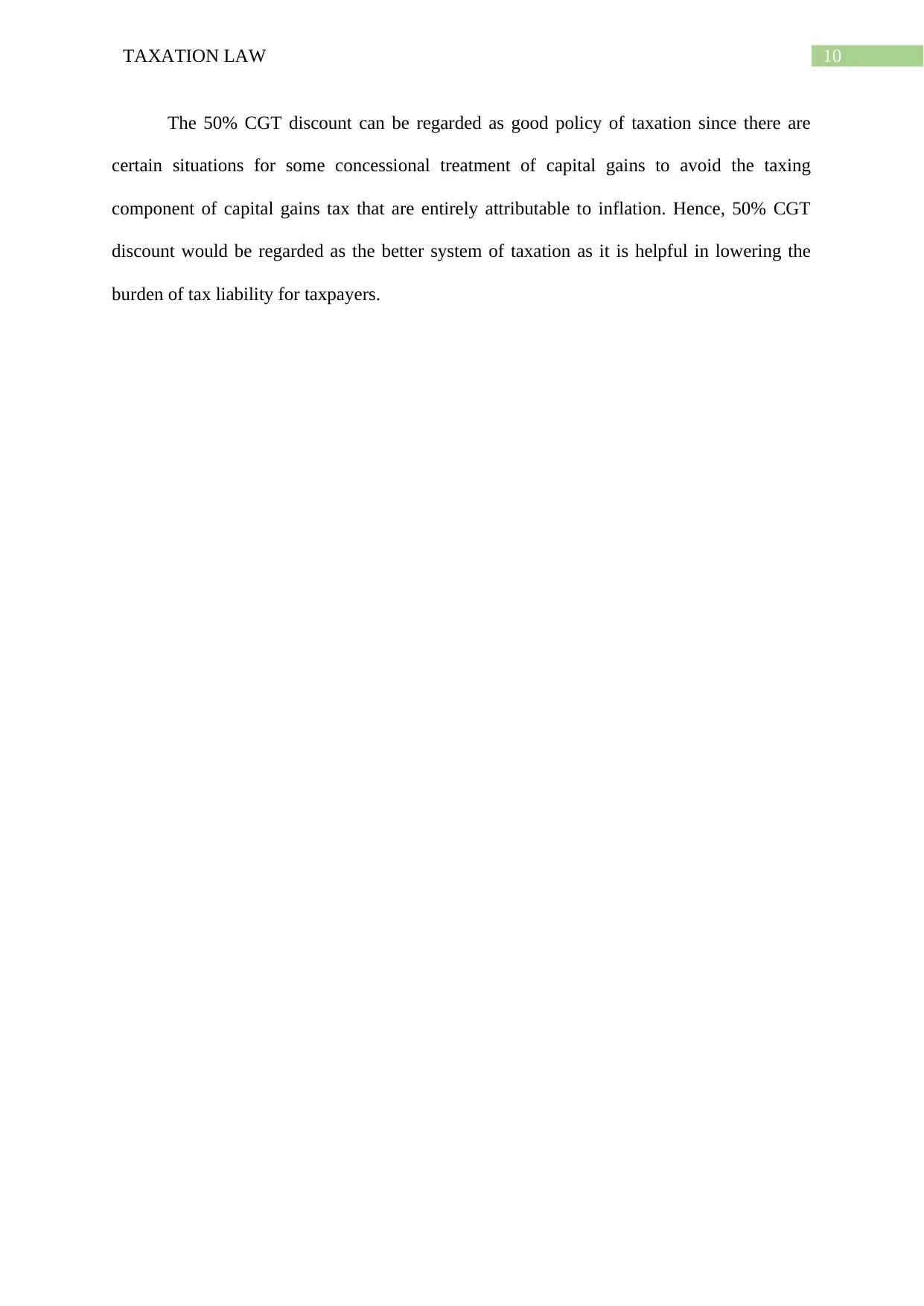
10TAXATION LAW
The 50% CGT discount can be regarded as good policy of taxation since there are
certain situations for some concessional treatment of capital gains to avoid the taxing
component of capital gains tax that are entirely attributable to inflation. Hence, 50% CGT
discount would be regarded as the better system of taxation as it is helpful in lowering the
burden of tax liability for taxpayers.
The 50% CGT discount can be regarded as good policy of taxation since there are
certain situations for some concessional treatment of capital gains to avoid the taxing
component of capital gains tax that are entirely attributable to inflation. Hence, 50% CGT
discount would be regarded as the better system of taxation as it is helpful in lowering the
burden of tax liability for taxpayers.
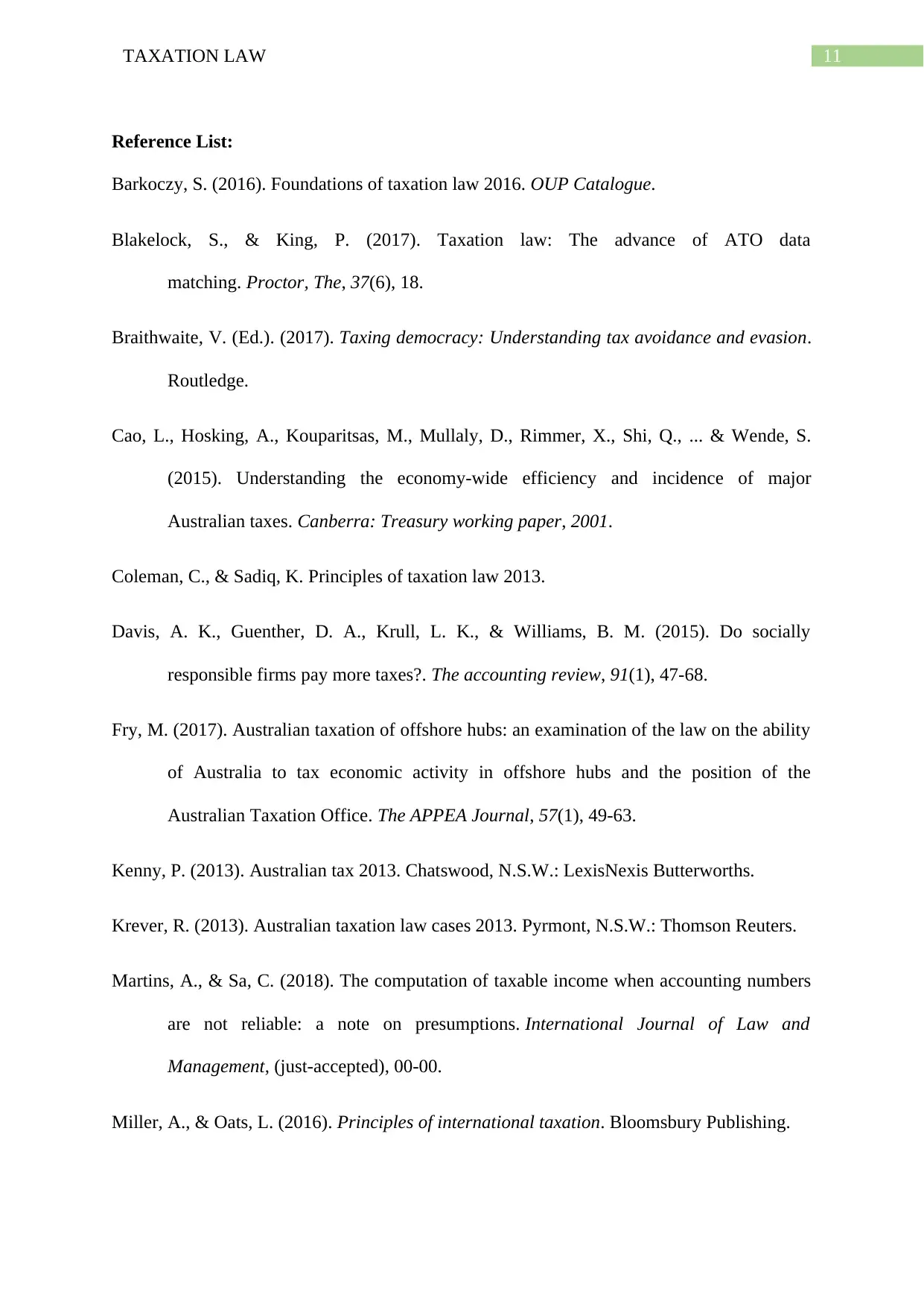
11TAXATION LAW
Reference List:
Barkoczy, S. (2016). Foundations of taxation law 2016. OUP Catalogue.
Blakelock, S., & King, P. (2017). Taxation law: The advance of ATO data
matching. Proctor, The, 37(6), 18.
Braithwaite, V. (Ed.). (2017). Taxing democracy: Understanding tax avoidance and evasion.
Routledge.
Cao, L., Hosking, A., Kouparitsas, M., Mullaly, D., Rimmer, X., Shi, Q., ... & Wende, S.
(2015). Understanding the economy-wide efficiency and incidence of major
Australian taxes. Canberra: Treasury working paper, 2001.
Coleman, C., & Sadiq, K. Principles of taxation law 2013.
Davis, A. K., Guenther, D. A., Krull, L. K., & Williams, B. M. (2015). Do socially
responsible firms pay more taxes?. The accounting review, 91(1), 47-68.
Fry, M. (2017). Australian taxation of offshore hubs: an examination of the law on the ability
of Australia to tax economic activity in offshore hubs and the position of the
Australian Taxation Office. The APPEA Journal, 57(1), 49-63.
Kenny, P. (2013). Australian tax 2013. Chatswood, N.S.W.: LexisNexis Butterworths.
Krever, R. (2013). Australian taxation law cases 2013. Pyrmont, N.S.W.: Thomson Reuters.
Martins, A., & Sa, C. (2018). The computation of taxable income when accounting numbers
are not reliable: a note on presumptions. International Journal of Law and
Management, (just-accepted), 00-00.
Miller, A., & Oats, L. (2016). Principles of international taxation. Bloomsbury Publishing.
Reference List:
Barkoczy, S. (2016). Foundations of taxation law 2016. OUP Catalogue.
Blakelock, S., & King, P. (2017). Taxation law: The advance of ATO data
matching. Proctor, The, 37(6), 18.
Braithwaite, V. (Ed.). (2017). Taxing democracy: Understanding tax avoidance and evasion.
Routledge.
Cao, L., Hosking, A., Kouparitsas, M., Mullaly, D., Rimmer, X., Shi, Q., ... & Wende, S.
(2015). Understanding the economy-wide efficiency and incidence of major
Australian taxes. Canberra: Treasury working paper, 2001.
Coleman, C., & Sadiq, K. Principles of taxation law 2013.
Davis, A. K., Guenther, D. A., Krull, L. K., & Williams, B. M. (2015). Do socially
responsible firms pay more taxes?. The accounting review, 91(1), 47-68.
Fry, M. (2017). Australian taxation of offshore hubs: an examination of the law on the ability
of Australia to tax economic activity in offshore hubs and the position of the
Australian Taxation Office. The APPEA Journal, 57(1), 49-63.
Kenny, P. (2013). Australian tax 2013. Chatswood, N.S.W.: LexisNexis Butterworths.
Krever, R. (2013). Australian taxation law cases 2013. Pyrmont, N.S.W.: Thomson Reuters.
Martins, A., & Sa, C. (2018). The computation of taxable income when accounting numbers
are not reliable: a note on presumptions. International Journal of Law and
Management, (just-accepted), 00-00.
Miller, A., & Oats, L. (2016). Principles of international taxation. Bloomsbury Publishing.
You're viewing a preview
Unlock full access by subscribing today!
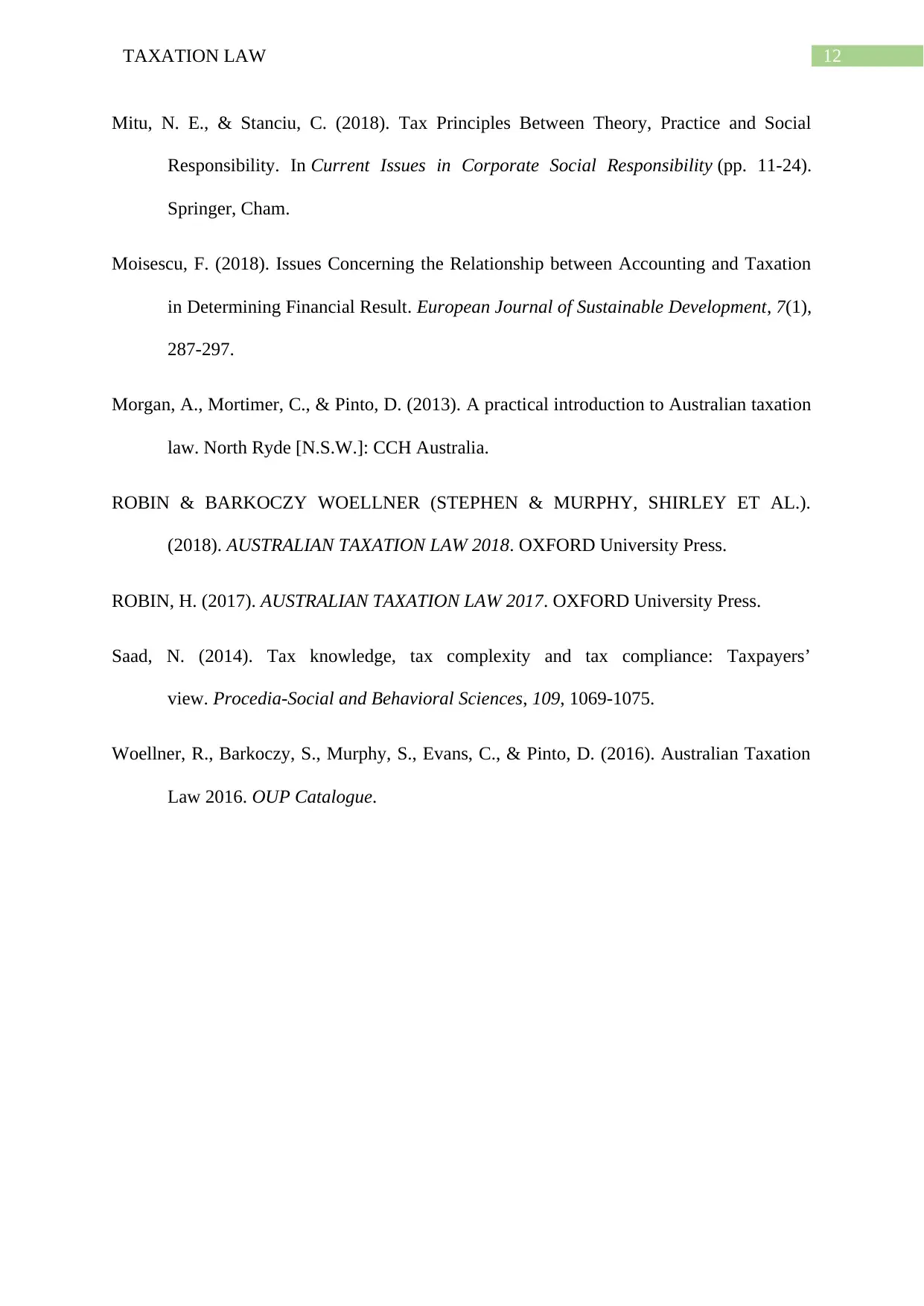
12TAXATION LAW
Mitu, N. E., & Stanciu, C. (2018). Tax Principles Between Theory, Practice and Social
Responsibility. In Current Issues in Corporate Social Responsibility (pp. 11-24).
Springer, Cham.
Moisescu, F. (2018). Issues Concerning the Relationship between Accounting and Taxation
in Determining Financial Result. European Journal of Sustainable Development, 7(1),
287-297.
Morgan, A., Mortimer, C., & Pinto, D. (2013). A practical introduction to Australian taxation
law. North Ryde [N.S.W.]: CCH Australia.
ROBIN & BARKOCZY WOELLNER (STEPHEN & MURPHY, SHIRLEY ET AL.).
(2018). AUSTRALIAN TAXATION LAW 2018. OXFORD University Press.
ROBIN, H. (2017). AUSTRALIAN TAXATION LAW 2017. OXFORD University Press.
Saad, N. (2014). Tax knowledge, tax complexity and tax compliance: Taxpayers’
view. Procedia-Social and Behavioral Sciences, 109, 1069-1075.
Woellner, R., Barkoczy, S., Murphy, S., Evans, C., & Pinto, D. (2016). Australian Taxation
Law 2016. OUP Catalogue.
Mitu, N. E., & Stanciu, C. (2018). Tax Principles Between Theory, Practice and Social
Responsibility. In Current Issues in Corporate Social Responsibility (pp. 11-24).
Springer, Cham.
Moisescu, F. (2018). Issues Concerning the Relationship between Accounting and Taxation
in Determining Financial Result. European Journal of Sustainable Development, 7(1),
287-297.
Morgan, A., Mortimer, C., & Pinto, D. (2013). A practical introduction to Australian taxation
law. North Ryde [N.S.W.]: CCH Australia.
ROBIN & BARKOCZY WOELLNER (STEPHEN & MURPHY, SHIRLEY ET AL.).
(2018). AUSTRALIAN TAXATION LAW 2018. OXFORD University Press.
ROBIN, H. (2017). AUSTRALIAN TAXATION LAW 2017. OXFORD University Press.
Saad, N. (2014). Tax knowledge, tax complexity and tax compliance: Taxpayers’
view. Procedia-Social and Behavioral Sciences, 109, 1069-1075.
Woellner, R., Barkoczy, S., Murphy, S., Evans, C., & Pinto, D. (2016). Australian Taxation
Law 2016. OUP Catalogue.
1 out of 13
Related Documents
Your All-in-One AI-Powered Toolkit for Academic Success.
+13062052269
info@desklib.com
Available 24*7 on WhatsApp / Email
![[object Object]](/_next/static/media/star-bottom.7253800d.svg)
Unlock your academic potential
© 2024 | Zucol Services PVT LTD | All rights reserved.


